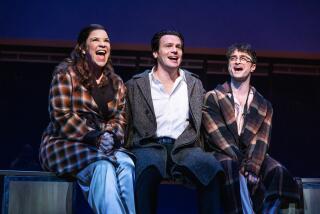Three Tenors (Saxophones) Get Into Hot, Cool Playing
- Share via
The tenor saxophone, for many listeners, is the ultimate jazz instrument. And it’s not hard to see why. From the first stirrings of Coleman Hawkins to the most recent recordings of Joshua Redman, the instrument has played a pivotal role in the music’s unfolding history. Capable of dark, sensuous sounds, it can also scream like a beast; cool, detached and floating in one player’s hands, it can be an instrument of astonishing technical virtuosity in another’s.
Listening to a range of current albums by tenor saxophonists, the first thought that comes to mind is the extent to which the influence of John Coltrane persists. Thirty years after his death, his style continues to serve as a model--perhaps too much so--in the hands of young artists.
But there also are players who follow different paths, who resonate with the sounds of other influences. Tommy Smith, surely the most famous jazz musician ever to emerge from Scotland, has been highly regarded, if not highly noticed, since his mid-’80s work with Gary Burton. And on “The Sound of Love” he reveals, at the relatively youthful age of 31, a linkage to a lush-toned style that reaches back to Hawkins’ legendary balladry.
Recorded in a little over six hours with a superb rhythm section that includes pianist Kenny Barron, bassist Peter Washington and drummer Billy Drummond, the album has a strikingly spontaneous feeling. Little glitches here and there, inevitable in a group of tracks that include many first takes, give the tunes a sense of immediacy, and the recording unfolds with the feeling of an evening in a jazz club with a fine group of musicians interpreting the immortal melodies of Ellington and Strayhorn. Barron is his dependably elegant self, and Smith’s soloing, generally close to the melody, is superb, never more so than in a stunning, utterly solo rendering of “Solitude.”
Among the numerous Coltrane descendants, none has done more to transform the style into a personal expression than Branford Marsalis. Distracted by other aspects of his career, he has not done a jazz quartet album since 1990. And the release of “Requiem” is a potent reminder of what the jazz world has been missing in the interim. Working on many of the tracks with the stunning rhythm team of pianist Kenny Kirkland, bassist Eric Revis and drummer Jeff “Tain” Watts, Marsalis completed the album without a pianist after Kirkland’s death in November.
Like his trio album “The Dark Keys,” “Requiem” is the spontaneous work of a performer with so many skills that it seems to be bursting in all directions--in this case even more so because of Kirkland’s titanic playing. Marsalis is alternately cool and hot, lyrical and explosive, imitative and original. His soprano work, sometimes rapturously sweet, moves without a second thought into tear-down-the-walls aggression. The brief moments when he allows his sound to reminisce about Coltrane are offset by an eclectic expression that roves through saxophone history to forge his own, personal articulation.
But, good as the playing may be, it carries a constant suggestion of how much Marsalis could accomplish if he made a more comprehensive effort to focus on his playing. Potentially one of the great jazz leaders of his generation, he has yet to assume his role in the music’s vanguard.
The tenor work of Charles Lloyd has often been viewed--in part because of his own musical decisions--as a kind of accessible version of Coltrane. His mid-’60s hit “Forest Flower” was a popularized, Coltrane-esque, modal-styled melody, and his playing into the present has retained similar qualities.
“Voice in the Night” showcases Lloyd in an extremely felicitous setting, accompanied by guitarist John Abercrombie, bassist Dave Holland and drummer Billy Higgins. Lloyd responds with some of his finest playing in years. Although the Coltrane echoes are still present, there are far more compelling moments in which his own personalized and still highly dynamic improvisational views take center stage.
He is aided enormously by his musical companions, an all-star ensemble if there ever was one. Abercrombie is particularly effective in tandem with Lloyd, and their let’s-have-fun interaction amid the boogaloo jazz rhythms of “Pocket Full of Blues” is as musically appealing as it is commercially viable. A remake of “Forest Flower,” however, wasn’t really necessary, and Lloyd is actually much more effective with Billy Strayhorn’s poignant “A Flower Is a Lovesome Thing.”
*
Albums are rated on a scale of one star (poor), two stars (fair), three stars (good) and four stars (excellent).
More to Read
The biggest entertainment stories
Get our big stories about Hollywood, film, television, music, arts, culture and more right in your inbox as soon as they publish.
You may occasionally receive promotional content from the Los Angeles Times.










